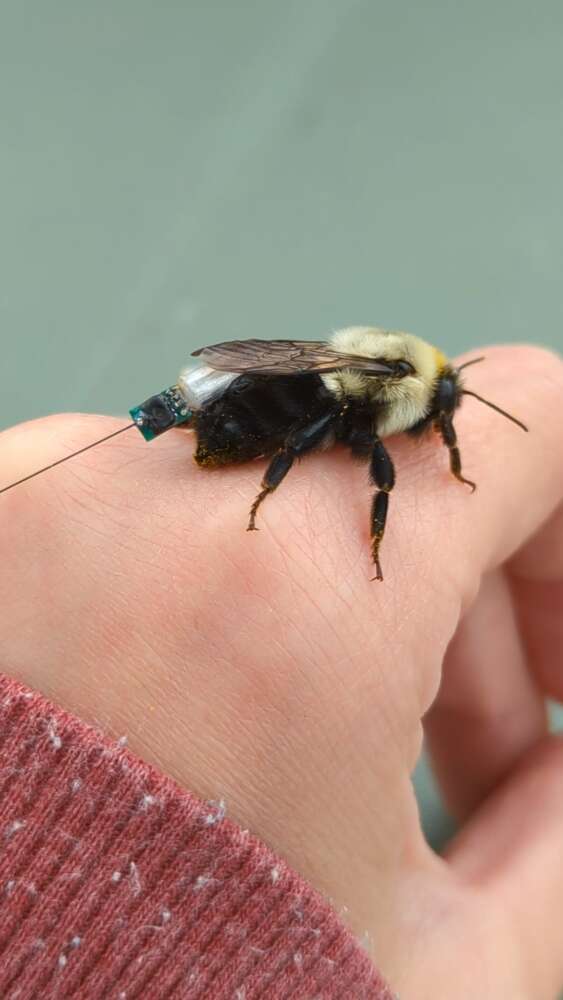
It’s common practice for farmers to apply insecticides to their crops, but one University of Guelph research team wants to know if the substances they’re using are pollinator friendly.
Dr. Amanda Liczner studies bumblebee behaviour as a post-doctoral researcher in the School of Environmental Sciences at the Ontario Agricultural College.
She and her research team superglued minuscule radio trackers to eastern bumblebee queens to determine how two insecticides — imidacloprid and cyantraniliprole — affect the insects’ movements and behaviour.
Imidacloprid is one of the three types of neonicotinoids, colloquially known as neonics, currently approved for use by Health Canada. Neonics are a class of insecticides that target the nervous system of an insect. In Canada, neonics are restricted because of the harm caused to wildlife, notably aquatic insects. Neonics are also known to cause high colony losses and significant population threats to bees.
Unlike neonics, cyantraniliprole targets the insects’ muscles. It’s currently poised as one possible insecticide to replace neonics and is commonly applied to fruits and vegetables.
Small but important animals
Because flying is taxing on a bee’s muscles, and because little is known about the potential effects of exposure to cyantraniliprole, it’s important to determine whether the insecticide could influence bumblebee flight, said Liczner.
“We don’t know a lot about the basic movement behaviour and ecology of bumblebees partly because they’re so small,” she said. “It’s hard to track bumblebee movement compared to a deer, which you can put a huge GPS collar on to get really good tracking information.”
Bees play a major role in pollinating crops. So, while Liczner’s research is specific to understanding how insecticides affect a bee’s flight, it also has larger implications.
“If we know more about a bee’s movement and how they choose which flowers they forage on, farmers will benefit because they’ll know what they need to do to get free pollination services and increase their yields,” she explained.
And all that information can come from a tiny radio transmitter on the back of a bee.
Like a backpack, but not

At the rare Charitable Research Reserve in Cambridge, Ont., Liczner and her team set up 43 radio towers. This past summer, they used the pings from these towers and hand-held receivers to monitor the movements of three groups of eastern bumblebee queens.
Like honeybees, eastern bumblebees have worker bees that gather resources for the colony. Eastern bumblebee workers, however, are too small to carry a radio tracker. Unlike honeybee queens, the Eastern bumblebee queens help in collecting resources early in spring before workers are born, making the queens suitable tracker carriers.
Out of 75 bumblebee queens, one group was exposed to imidacloprid and the second to cyantraniliprole. Queens in a third control group were fed sugar water and not subjected to insecticides.
Each queen carried a tracker on its abdomen weighing less than 0.13 grams, which is just under 30 per cent of their overall weight. Coincidentally, 30 per cent is also the proportion of body weight the insect can carry as pollen.
“It’s definitely a weight on them,” said Liczner. “I like to make the analogy of people walking around with a backpack with stuff in it. Obviously, we’d rather not be carrying a backpack around, but we do it.”
Continuing previous research on bees

In earlier research, Liczner used radio tags to determine where bumblebee queens hibernate and to see how exposure to different pesticides might affect their behaviour.
Dr. Nigel Raine, her supervisor, has used a range of technological solutions (including ground-based harmonic radar and radio frequency identification tags) to monitor the behaviour of bumblebees.
“We’re really excited to be tracking patterns of queen bumblebee movement with radio tags in the field,” said Raine. “Our array of tracking towers is helping us learn so much more about the fundamental ecology of these important pollinators and their movements throughout their life cycle.”
The team is currently collecting the final data from the radio towers for the next step of the project.
They will look at the bees’ flight paths, lengths and times, and how much time they spent among flowers. They’ll also use the data to see whether the queens started to build nests.
“Our current agricultural system really can’t sustain not using any insecticides, so it’s really important to know how cyantraniliprole compares to neonics,” said Liczner. “If it’s better, great. If it’s worse, we really, really need to know that.”
This project is funded by the Natural Sciences and Engineering Research Council, the Canada Foundation for Innovation, the Ontario Research Fund, U of G’s Food from Thought project, the Canada First Research Excellence Fund, and the Weston Family Foundation.
Contact:
Dr. Amanda Liczner
licznera@uoguelph.ca
Dr. Nigel Raine
nraine@uoguelph.ca
